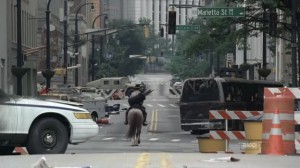The Walking Dead – “Days Gone By”
“You cozy?”
The Walking Dead holds a special interest for me. I’ve never read the comic. I’m not really a horror or zombie movie fan. Media properties operating in a dystopic post-apocalypse are exhausting.
But that tank scene at the end was shot two blocks from my old apartment.
Before I moved to LA two months ago, I lived in the metro Atlanta area for 17 years, inside or on the fence (I-285) for 11. I know a lot of people that have either worked in the production as extras, PAs, or other minor roles as well as people that have worked on the post-production of each episode (apparently they shot A LOT of footage in order to get every angle of walker attacks). I’ve been through their struck sets and watched people made up as ghouls amble toward Five Points station. Atlanta is a city I am very familiar with.
For instance, I know that the the scene where Rick rides the horse “into” town (the one also depicted on the poster) shows him on Freedom Parkway heading into downtown while everyone else seems to be heading toward Little 5 Points, as if commercialized bohemians were going to save them. And that he’s facing I-85, not coming from it.
All that aside, I feel like The Walking Dead does do something special for the horror genre. While it doesn’t necessarily tread new ground in an industrial sense, it does do something that horror movies have trouble achieving in their 90-minute running time. Here, they have the opportunity to build complex characters and stories at AMC speed.
Zombie movies don’t tend to have super-defined characters. Generally, we have pockets of survivors battling the hordes of undead while we focus on the one person that’s either late to the party or is somehow special within the context of the horror dynamic (immune to the disease, etc). Think 28 Days Later or Resident Evil. They also have to define the fiends quickly. Characters, despite their enemy looking like sickly versions of themselves, generally have no problem putting down a zombie. We presuppose the ability for a mentally-stable human to comfortably kill what is, for the most part, another human being because they are acting out of a desperate measure of self-defense. Kill them or they will kill you.
What episodic storytelling brings to this genre is a little more complexity and a bit more heart. Rick and Morgan are conflicted about what they need to do to survive. Rick’s first walker kill, beating what looks like a pale, bleeding vagrant with a baseball bat, requires that he take a moment before moving on. Morgan has his wife, a walker that often returns to the house she last saw her family, in the crosshairs of a rifle and still can’t pull the trigger to kill her (even if his survival skills over the past few months allow him to easily kill other ghouls). Instead of having to jump directly from confusion about what is happening to the militia assembled to put them down, a speedy narrative necessary to fit in allotted time before a horror movie gets to be too long, the episodic allows the characters (and its audience) meditate on the effect this outbreak has on the psyche of its survivors. We are privy to the transition stage between lost non-zombie and jaded zombie slayer.
Rick returns to the park where he saw a legless “walker” (in quotes because she has no legs) for the sole purpose of putting her out of her misery. As fearful as they are of being infected, there’s still an understanding that these are people, suffering people, and that their deaths don’t only mean continued life for the survivors but also, possibly, releasing the zombies from pain. To me, this is what The Walking Dead brings to the table: emotional resonance in a genre that rarely has the time to dedicate to it.
All of this in a very AMC-style of programming. The network has put a lot of effort into developing series that doesn’t talk down to the audience, are often very subdued, and move at a much slower pace. Despite the subject matter and several action sequences, we see the same things here: from the whispery conversations and lack of soundtrack in most of the show (just as much a horror trope as it is an AMC one) to the storytelling that unfolds without being terribly obvious. An example of the latter is how we find out Shane has scooped up on Rick’s wife/girlfriend/lady Lori. While we assemble the pieces provided to us that the mother and son in the camp are the family Rick is searching for, a less subtle show would make sure to mention Carl’s name at some point of the camp scene. Instead, the scene is only followed up with a picture of the family together, showing us a visual resolution rather than making sure the audience knows by telling us. Showing and not telling is always good.
With most of the series premieres I’ve struggled to watch recently, I feel obligated to say that pilots are hard. But this one does a great job of establishing tone, setting up storylines, creating stakes, and introducing everyone to style. If it continues in this way, the show really has potential. And I’m not just saying that because Rick blew some zombie aways on a Forsyth Street lined with the “G” logos of my alma mater.
- November 1, 2010
- Nick
- Episode Review
- Series Premiere, The Walking Dead


